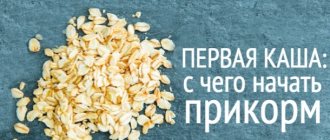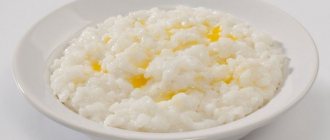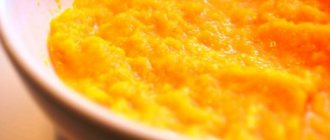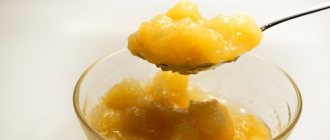Buckwheat for children with cheese and butter
Peeled and washed buckwheat is boiled in water in a ratio of 1:3 for about 15 minutes. Remove from the hot plate and cover, leaving to rest for 10 minutes.
While the cereal is cooling, add a teaspoon of butter and desalinated cheese (Ricotta, Mozzarella, Cheddar, etc. If the cheese seems too salty, a piece can be soaked in water and only then given to the baby). A very healthy and nutritious dish for kids.
When it's time to introduce buckwheat into your baby's diet
It depends on what product you decide to start feeding your baby with. If it is porridge, in particular buckwheat, then it should be introduced from 6 months for breastfed babies and from 4 months for formula-fed babies.
For example, I started feeding my son with vegetable puree. Therefore, our introduction of cereals has shifted by almost a month (the interval between the introduction of new products should be at least 3 weeks). Thus, he tried buckwheat for the first time at almost 7 months.
Cream soup of zucchini and buckwheat
2 tablespoons butter 1 lemon leek 2-3 zucchini 3 tablespoons buckwheat 2 cloves garlic pinch thyme - dry
2 tablespoons yogurt 1 tsp. flour
Stew finely chopped leeks in butter, add thyme, add hot water, and after cooking, add chopped zucchini and well-washed buckwheat. Finally, add the garlic.
Make a sauce from yogurt and flour and add to the soup. Serve with chopped parsley.
If you are not a fan of flour, you can serve the soup with 1 tsp. low-fat sour cream per serving.
Sample menu for each day of the week
You can cook a wide variety of dishes for your little ones. Here is an approximate daily menu for one week, with the first (breakfast No. 1) and last feeding of the child (dinner) being breast milk or infant formula.
| Day of the week | Eating | What can you offer your baby? |
| Monday | Breakfast No. 2 | Semolina porridge with dried fruits (150 g), cottage cheese with peach pulp (50 g), pear puree (50 g). |
| Dinner | Cabbage and pumpkin puree (180 g), turkey mousse (70 g), 1/2 yolk, compote (150 ml), bread. | |
| Afternoon snack | Homemade yogurt (100 g), buckwheat porridge (50 g), green apple puree (50 g), children's cookies (5 g). | |
| Tuesday | Breakfast No. 2 | Buckwheat porridge with pumpkin (100 g), plum puree (50 g), children's cottage cheese (50 g). |
| Dinner | Potato soup with meatballs with onions, cabbage, carrots, herbs (200 g), pear and peach puree (50 g), bread. | |
| Afternoon snack | Children's kefir (100 ml), oatmeal (100 g), green apple, baked in the oven. | |
| Wednesday | Breakfast No. 2 | Rice pudding (100 g), jelly (50 g), curd soufflé (50 g). |
| Dinner | Pumpkin soup (200 g), fish cakes (50 g), fruit juice (50 g), bread (5 g). | |
| Afternoon snack | Homemade yogurt (100 ml), corn porridge with pear and apple (100 g) crackers. | |
| Thursday | Breakfast No. 2 | Oatmeal with berries (100 g), children's cottage cheese (50 g), chopped prunes. |
| Dinner | Vegetable puree from broccoli and rabbit meat (200 g), peach puree (50 g), fruit juice (80 g), bread (5 g). | |
| Afternoon snack | Kefir for children, rice porridge (100 g), children's cookies (5 g). | |
| Friday | Breakfast No. 2 | Corn porridge with pear (100 g), children's cottage cheese (50 g), pear puree (50 g). |
| Dinner | Chicken soup (200 g), pear puree (50 g), berry juice (70 g), bread (5 g). | |
| Afternoon snack | Homemade yogurt (150 g), children's cookies (5 g), barley porridge (100 g). | |
| Saturday | Breakfast No. 2 | Buckwheat porridge with peach (100 g), cottage cheese for children (50 g), fruit juice. |
| Dinner | Puree of zucchini, carrots, turkey meat (200 g), baked apple with berries, bread (5 g). | |
| Afternoon snack | Kefir (150 ml), crackers, oatmeal (100 g), applesauce (50 g). | |
| Sunday | Breakfast No. 2 | Barley porridge with pumpkin (100 g), cottage cheese with plum (50 g), fruit jelly. |
| Dinner | Vegetable soup with beets (180 g), fish puree (50 g), fruit puree from peach and pear (50 g), compote (100 g). | |
| Afternoon snack | Yogurt with pear puree (150 g), children's cookies, buckwheat porridge (100 g). |
Buckwheat for children: recipe for tomato soup with buckwheat
1 cup grated fresh tomatoes 1 small carrot 1 teaspoon olive oil pinch salt 130 ml buckwheat parsley
Boil buckwheat with grated carrots, add grated tomatoes and oil as they cook. When the buckwheat is cooked, remove the soup from the stove and add finely chopped parsley.
Rules for preparing baby food for an infant
- At this age, you can gradually wean your baby off grated food and introduce him to coarser foods. After all, the baby already has enough teeth, and he is already quite capable of using them for their intended purpose.
- At first, instead of a blender, you can use a grater with small holes, then, if everything goes well and the baby does not protest, you can simply mash the food with a fork.
- It is possible that such food may initially cause a gag reflex in the child, but do not be afraid of this - the baby will get used to it over time.
- Product processing is also important in this case. Food should be steamed, stewed or boiled.
Children's casserole with buckwheat (suitable for older children)
250 g buckwheat 2 onions 6-7 potatoes olive oil or sunflower oil 300 ml grated tomatoes parsley salt
For the sauce:
3 eggs flour 2 tbsp. 1/2 cup yogurt 1 tsp. butter
Buckwheat is cooked in about 500 ml of water for about 15 minutes. During this time, sauté the onion in a small amount of olive oil, add grated tomatoes, salt and basil. Cook over low heat for about 5 minutes. Potatoes are prepared as usual for moussaka - cut into thin cubes or thin slices.
Melt the butter in a saucepan over low heat. Add flour and stir, continuing to heat the butter-flour mixture. Pour in the yogurt in small portions, stirring constantly with a wooden spatula. Stir the sauce until smooth.
Place the potatoes in the first layer on a baking sheet, sprinkle with salt and parsley, and add buckwheat in the second layer. Pour the sauce on top, sprinkle with parsley and bake at 200 degrees for 30-40 minutes.
Food and diet for a 9 month old baby
At nine months, the child eats almost all foods from the adult table. The baby's menu is varied and nutritious. At the tenth month of life, the baby is still content with mother's milk or an adapted milk formula in the morning and evening. Read on to find out which products are already on your baby’s menu and which ones should be included in complementary foods.
- Vegetables. Now the baby is already eating zucchini, potatoes, onions, cauliflower, carrots, pumpkin and green peas. In the tenth month of life, the child can be offered beets, unless, of course, he has problems with stool. After all, beets have a pronounced laxative effect. In addition, you can include broccoli in your baby’s menu. This is a very useful product, containing a lot of useful substances that are vital for a growing body. Just don’t cook soups based on this vegetable. When broccoli is cooked, toxic components are released into the broth. You can serve beets and broccoli as purees, or add them to soups and meat dishes. The baby should eat 200 g of vegetables per day.
- Meat. During this period, the child already eats turkey, rabbit and veal. If these types of meat are well tolerated by the baby, then at nine months you need to introduce him to chicken, beef, pork and horse meat. The meat is served in the form of a soufflé, added to vegetable purees, soups, and broths are made on its basis. A child should eat 60 to 70 g of meat per day.
- Fruits and dried fruits. The following fruits are allowed: plum, green apple, pear, peach, apricot, dried fruits, banana, black and yellow currants. If the baby does not have allergies, then at this age he can be introduced to gooseberries and red currants. Fruits should be served in the form of puree, added to yogurt, cottage cheese. The baby should eat from 90 to 100 g of fruit puree per day.
- Porridge. In the tenth month of life, in addition to the already familiar rice, corn, buckwheat, barley, and oatmeal, the baby is introduced to semolina and pearl barley. The basis for cooking porridge is water, mother's milk or milk mixture. The cereals are boiled, then crushed using a blender. Porridges are served with fruit, boiled egg yolk and vegetables. The optimal norm for this age is 200 g.
- Beverages. At the moment, the child drinks purified or boiled water, juices made from vegetables and fruits (half diluted with water). In addition, the baby is offered raisin-based decoctions, jelly, and compote made from dried fruits (without added sugar). There is no need to give cow's or goat's milk to a child in the tenth month of life, since these products are difficult for the child's body to digest.
- Greenery. Greens are a real storehouse of useful elements and vitamins. A nine-month-old baby can first be introduced to dill and parsley. These greens are not yet consumed in their raw form, but are introduced in chopped form when preparing a dish. The daily norm is 5 g.
- Fish. If the child is still fed with mother's milk, then fish is introduced only now - at nine months. An artificial child begins to eat this product one month earlier. Acquaintance should take place with dietary varieties of sea fish - hake, pollock, haddock, flounder. If allergies are not observed, then you can serve dishes of cod, pike perch and salmon to the children's table. Fish is added to vegetable purees, soups, and served as soufflés and purees. A child should eat no more than 40 g of fish per day. It is recommended to consume the dish twice a week.
- Fermented milk products. At nine months, the child already enjoys cottage cheese (the norm is 50 g) and natural yogurt or kefir (200 ml). To add variety and improve taste, fruits and dried fruits are added to them.
Advantages and disadvantages of ready-made complementary foods and those prepared at home
Many doctors recommend feeding babies industrial food. This is due to the fact that such food does not contain chemicals, preservatives or dyes. Ready-made baby food contains no salt, sugar or seasonings. It is absolutely harmless. You can also rest assured about meals that contain meat. The contents of the jars undergo strict quality control; they do not contain foreign additives, harmful substances, hormones, or antibiotics. Of course, if you are confident in the quality of meat or live in an ecologically clean area and grow your own vegetables and fruits, then this is without a doubt the best option for feeding your child.
Which porridge should I give first?
On this issue, the opinions of mothers are different: some prefer to start giving home-produced cereals first, while others buy ready-to-eat cereals.
But pediatricians recommend starting complementary foods with store-bought ones, which contain a full range of balanced substances and vitamins required for the child’s body. Their composition promotes better absorption for children's intestines.
Nowadays, on store shelves there is a huge selection of such products for different age categories of children.
Ready-to-eat cereals
Most products in this category contain inulin. This is a prebiotic that not only improves digestion, but also stimulates the development of all the necessary bacteria in the walls of the digestive tract. Normalizes stool. Useful for children suffering from constipation.
Before use, the product is poured into a feeding container. Heat in the microwave or in a water bath. Porridge in its original packaging cannot be placed in the microwave. Before feeding, baby food is mixed. If a child eats porridge from a bag, shake it well before eating.
There are three types of porridge in blue packaging: rice, buckwheat and cereal (buckwheat, corn and rice), and three types in white packaging: oatmeal, oatmeal with banana and buckwheat with apples.
The company produces two more types of ready-made porridge in glass jars. These are thicker foods that are not meant to be drunk and are eaten with a spoon. Before eating, transfer the porridge into a bowl and heat it up. Can be heated in a glass jar in the microwave.
- whole milk powder (only in milk porridges);
- finely ground cereal;
- 12 vitamins and 3 minerals;
- prebiotics;
- fruits and vegetables, with the exception of one-ingredient cereals.
All ingredients are natural. This porridge not only satisfies hunger, but also enriches the body with all the necessary nutrients and improves the functioning of the gastrointestinal tract.
The composition of ready-made porridges is somewhat different from dry ones. Here the main ingredients are:
- whole milk;
- cereals;
- inulin;
- maltodextrin;
- thickener in the form of corn starch;
- acidity regulator - sodium citrate;
- drinking water.
Ready-made cereals in glass jars contain:
- boiled cereals;
- berry and fruit puree;
- sugar;
- water.
Reviews of FrutoNyanya cereals
The products of the Lipetsk plant received many positive reviews from customers. Here are some of them:
All products of the Lipetsk plant are completely natural. It helps parents save time and energy and opens up opportunities for varied nutrition for little gourmets.
During the manufacturing process, no dyes, preservatives, artificial chemical additives or thickeners are added to the porridge. Allowed for use from the age of four months.
- fruit juices and nectars;
- fruit and fruit and berry puree;
- drinking cocktails made from berries and fruits;
- vegetable puree, ideal for first feeding;
- meat puree;
- purified water for children;
- jelly;
- fruit drinks;
- milkshakes;
- vegetable nectars;
- dairy and dairy-free porridges;
- liquid porridge.
All products are hypoallergenic. They have a low level of immunogenicity and do not cause allergies. They are reliable assistants in child care.











